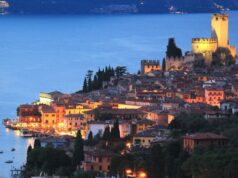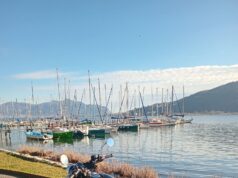How Deep is Lake Garda
How Deep is Lake Garda? Exploring the Depths of Italy’s Largest Lake
Located in northern Italy, about halfway between Venice and Milan. It straddles the border between Lombardy, Veneto and Trentino-Alto Adige regions.
Beneath the crystal clear waters of Lake Garda lies an underwater landscape still being uncovered. As the largest lake in Italy, Garda stretches 32 miles in length but reaches depths over 1,000 feet in places. Its gleaming surface and quaint villages evoke Mediterranean charm, yet hidden below is a world shaped over millions of years.
Carved by a long-vanished glacier, Lake Garda’s depths reflect its Ice Age origins. A deep valley running north-south divides the lake into two major basins. The southern section plunges rapidly to over 300 meters offshore, with its deepest recorded sounding of 346 meters near Tignale. The flatter northern basin averages 50-100 meters in depth, reaching a maximum of 263 meters.
This bathymetry results from Garda’s position within a major fault zone bordered by limestone cliffs and moraine hills. Softer sediments fill the central rift valley, while robust tributaries feed the lake year-round. The outlet Mincio River prevents overflow. In concert, these geological forces sculpted Lake Garda’s irregular underwater topography over eons.
Ongoing research is illuminating Garda’s elusive deep ecosystems. Through bathymetric mapping and scientific diving, features like underwater canyons, thermal streams, and ancient ruins have been revealed. More mysteries likely await in the dark lake garda depths.
While Garda’s beauty captivates from above, the lake’s true scale only becomes clear below the surface. Its extreme depths and hidden contours are integral to its character. Lake Garda remains an environment forged as much by the forces within its depths as the spectacular landscape of the surrounding Italian Alps. Even locals unaware of what lies beneath the lake they love would surely marvel at the secrets Garda holds in its unseen depths.
How Big is Lake Garda
Sizing Up Italy’s Spectacular Lake Garda.
With its postcard-perfect villages, soaring cliffs, and azure waters set against a dramatic Alpine backdrop, Lake Garda offers some of Italy’s most spectacular scenery. But beyond its stunning natural beauty, this renowned lake has another claim to fame – its mammoth size.
How Long is Lake Garda
Stretching across Northern Italy’s Lombardy and Veneto regions, Lake Garda is the country’s largest lake. It measures an impressive 51.6 km (32 miles) long while spanning 19.6 km (12 miles) at its widest point. The total surface area covers 370 km2 (143 square miles).
To put that in perspective, Lake Garda’s surface is larger than well-known lakes like Como, Maggiore, and Lugano combined. It has double the area of the famous Lac Leman in Switzerland. Only five other lakes in Italy exceed Garda’s immense proportions.
Let’s explore the sheer scale of Lake Garda through facts and figures:
Length: 51.6 km (32 miles)
Spanning over 50 kilometers in length, Lake Garda is impressively long. If stood upright, it would be taller than 50 Eiffel Towers stacked end-to-end. It’s nearly the same length as the English Channel between England and France.
At 52 km, you could walk the entire length of Lake Garda’s shoreline in about 18 hours at a leisurely pace. Or you could drive it in just under an hour when traffic is light. Ferries and hydrofoils connecting towns like Sirmione and Riva del Garda take advantage of Garda’s elongated shape.
Width: 19.6 km (12 miles)
While long, Lake Garda is also exceptionally broad. Its widest point measures 19.6 kilometers across from San Vigilio to Brenzone on the eastern shore.
To cross the lake’s width at this point would take a moderate swimmer around 5 hours, or a motorboat zipping at 30 mph approximately 24 minutes. The imposing Italian Alps and softer moraine hills framing the water accentuate Garda’s wide horizons.
Surface Area: 370 km2 (143 square miles)
Lake Garda’s immense length and width give it a surface area of 370 square kilometers. That’s equivalent to 143 square miles.
To visualize how sizable that is, you could fit the city of Chicago (606 square km) inside Lake Garda’s surface area with room to spare. It’s over 20 times larger than other vacation lakes like Lake Tahoe in California and Nevada.
Shoreline Length: 158 km (98 miles)
The shoreline encircling Lake Garda’s huge surface area stretches approximately 158 kilometers, or 98 miles.
Driving at 55 mph, you’d need nearly 2 hours to complete a loop around the entirety of Lake Garda’s perimeter. Fortunately, you can stop in charming villages like Sirmione and Malcesine along the way.
The mountainous terrain surrounding the lake creates a convoluted shoreline with long peninsulas and indented bays that add to its length. This varied geography contributes to Garda’s stunning scenery.
Volume: 49 km3 (12 cubic miles)
Containing 49 billion cubic meters (59 billion cubic yards) of water, Lake Garda ranks among the largest lakes in Europe by volume. That’s equal to around 12 cubic miles of water.
To help conceptualize just how much water that is, Lake Garda could flood the entire island of Manhattan up to a height of over 300 feet. It’s enough liquid to fill 19 million Olympic swimming pools.
Max Depth: 346 meters (1,135 feet)
It’s also one of the deepest in Europe with a maximum depth of 346 meters.
In some parts, Lake Garda plunges to impressive depths. Its deepest point of 346 meters (1,135 feet) was recorded just off the town of Tignale along the southwest banks.
To reach this depth, you’d need to stack up nearly 7 Statues of Liberty on the lakebed. It rivals famous deep lakes like Lake Tahoe, which measures 501 meters at its deepest point. Underwater cliffs and valleys carved by glaciers account for Garda’s Mediterranean blue hue.
It was formed from a glacier during the Ice Age and has a unique shape, composed of several different branches/fingers. The Sirmione peninsula divides the south part of the lake into two sections.
Lake Garda rightfully deserves its distinction as Italy’s largest lake based on its sprawling dimensions. While mere statistics can’t convey the full beauty of Garda’s turquoise waters set against craggy peaks, they help quantify the sheer mammoth scale of this natural wonder. Whether measured in miles, acres, or cubic meters – Lake Garda represents one of Europe’s grand lake landscapes.
Lake Garda’s deepest point
At its deepest point, the lake reaches a maximum depth of 346 meters (1,135 feet). This deepest section is situated between the towns of Castelletto di Brenzone and Muslone along the lake’s eastern shore. With depths exceeding 300 meters, Lake Garda is one of the deepest lakes in Europe. The incredible depth is a result of the lake filling a glacier-carved valley surrounded by mountains. The lake’s deepest point provides a unique environment and habitat for aquatic life and contributes to the lake’s scenic natural beauty.
Facts about Lake Garda
- Lake Garda has a subalpine microclimate with Mediterranean vegetation due to its sheltered position between mountains. Lemon trees and olive groves grow in the area.
- Tourism is a major industry, and the lake region draws visitors for its natural scenery, mild climate, food, wine, fishing, water sports, and cultural attractions year-round.
- Many sports competitions take place on or around the lake such as sailing regattas, cycling events, Ironman triathlons, and the Red Bull Cliff Diving World Series.
- In literature, Lake Garda has been featured in the works of famous writers like D.H. Lawrence, Mary Shelley, and Aldous Huxley who lived nearby for a period.
FAQs: How Deep is Lake Garda?
What is the depth of Lake Garda?
Lake Garda’s maximum depth is approximately 346 meters (1,135 feet).
How deep is Lake Garda in miles?
Lake Garda is about 29 miles long, but its depth varies. The maximum depth is approximately 346 meters.
How deep is Lake Garda in feet?
The maximum depth of Lake Garda is approximately 1,135 feet.
What is the size of Lake Garda in square miles?
Lake Garda covers an area of about 143 square miles.
How big is Lake Garda in miles?
Lake Garda is approximately 29 miles long from north to south.
What is the average depth of Lake Garda?
The average depth of Lake Garda is around 136 meters (446 feet).
Where is the deepest point of Lake Garda located?
The deepest point of Lake Garda, known as the “Fondo del Garda,” is located near the town of Malcesine on the eastern shore.
How does the depth of Lake Garda compare to other Italian lakes?
Lake Garda is the deepest of the Italian lakes, with a maximum depth greater than Lake Como and Lake Maggiore.
What causes the varying depth of Lake Garda?
The lake’s depth varies due to its complex geological history and the presence of deep underwater canyons.
Is Lake Garda safe for swimming given its depth?
Yes, Lake Garda is generally safe for swimming in designated areas, and its depth doesn’t affect the safety of recreational swimming.
Are there any underwater caves or features in Lake Garda due to its depth?
Yes, Lake Garda has several underwater caves, particularly in the northern part near Malcesine, which are popular for diving.
How has the depth of Lake Garda changed over time?
The lake’s depth has remained relatively stable over geological time, but it may have experienced minor fluctuations.
Can you see the bottom of Lake Garda from the surface?
In some shallower areas, you may be able to see the lakebed from the surface, but not in the deeper parts.
Are there any shipwrecks at the bottom of Lake Garda due to its depth?
Yes, there are historical shipwrecks at the bottom of the lake, including World War I-era vessels.
What are the temperature variations at different depths of Lake Garda?
Lake Garda experiences a significant thermal stratification, with temperatures varying at different depths.
How does the depth of Lake Garda impact its wildlife?
The varying depths support a diverse ecosystem, with different species of fish and other aquatic life at various levels.
Is it safe to go boating or fishing on Lake Garda given its depth?
Yes, boating and fishing are popular activities on Lake Garda, and safety measures are in place for recreational activities.
Can I go scuba diving to explore the depths of Lake Garda?
Yes, scuba diving is popular, especially in the northern areas, where divers can explore underwater caves and walls.
How is the water quality affected by the depth of Lake Garda?
The depth contributes to the lake’s excellent water quality, making it suitable for various water sports and activities.
Is there a designated area where I can measure the depth of Lake Garda for educational purposes?
While there may not be specific measuring points, you can find educational resources and guided tours to learn about the lake’s depth and geology.











